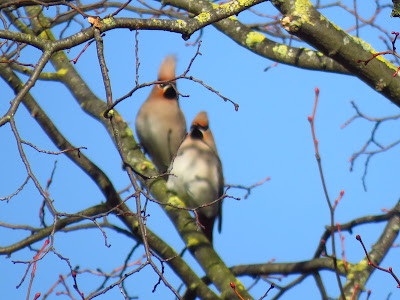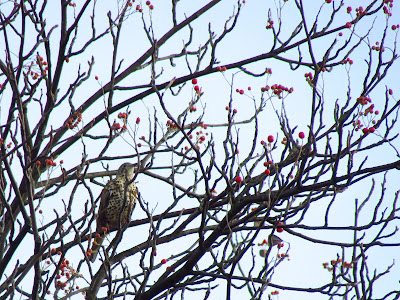
Several bird species hold territories during the winter, like Robins or Wrens defending their patch and singing through the winter. It is rarer that a pair will defend a winter territory. I have covered examples like Stonechats and Pied Wagtails before. The former usually include a male and a female, but they are unlikely to be a mated pair.
A pair of Mistle Thrushes near their cotoneaster tree. Northern Cemetery 30/11/21.
Earlier in the week I saw some Rowans heavy with berries along a street. A Mistle Thrush sat on a taller tree nearby. Then another individual flew from the berry tree, a pair! Later in my walk, I saw another pair of Mistle Thrushes near their defended cotoneaster (above). I then realised seen paired Mistle Thrushes in the winter before, near their defended trees. Are they a resident pair? Is a pair better than a single individual defending their berry larders?
Clockwise from top left, Yew, Ivy, Rowan and Holly ripe berries.
The berries
Mistle Thrushes are well known for their winter defence of berry resources. Holly is one of the most important defended trees in the UK, followed by Hawthorn, Mistletoe, Yew and, later in the winter, Ivy. At Hull, I've seen Mistle Thrushes defend Holly, Yew, Rowan, Whitebeam and Cotoneaster. Often the same trees are defended year after year.
Mistle Thrush on defended holly, one of an Avenues of Hollies at East Park defended by a pair, 23rd November 2021.
Mistle Thrush overlooking its defenced Rowan, 1st February 2021.
Mistle Thrush on General Cemetery on its defenced Whitebeam at Pearson Park. 17th October 2014.
Mistle Thrush on its defended berry-laden Yew.
A Mistle Thrush atop the church rooftop checks the yew opposite, on Cottingham Road Community Church garden. 14th November 2017.
Defence behaviour
Aggressive tree defence behaviour is spectacular: The Mistle Thrushes use their loud rattling or churring calls, repeatedly and chases other birds away from their tree. Most aggressive interactions involve repelling other Mistle thrushes, but also any other thrushes, like Blackbird, and various finches, Great Spotted Woodpeckers, Waxwings and even single Woodpigeons. Defence consists on chasing intruders, often silently and even if the birds were feeding on fallen berries under the tree. If there is a conflict then the individual might flick its tail and wings, their white underwings flashing, while churring persistently. Churring also occurs in flight during chases. Their defence is effective due to their large body size - they are the largest European thrush. Curiously Barbara and David Snow, who studied this behaviour in the UK note how the Mistle Thrush chooses who to attack carefully and it will chase only some species away so long as they are food competitors for the particular tree it is defending. For example Starlings are left alone in hawthorn and holly (whose berries they rarely eat) but chased from Ivy, which they eat. Greenfinches and Great Tits, are chased from Yew (they feed on the seeds) but not from Holly, which they don't eat. Eventually, after a few attacks, the local birds will learn to avoid the defended trees, and the Mistle Thrush just watches from a distance, and often this is how you'll find a Mistle Thrush, sitting on a vantage point near its precious tree.
Establishment of the guarded tree
Snow and Snow describe that the system of tree defence is established in October or early November, when song might be occasionally heard and other Mistle Thrushes are vigorously driven off until the territory is set. That way they can exclusively feed on these berries through the winter when they are needed. The defended trees become their winter larders, standing out on the landscape, packed full of berries when all other trees have been stripped out. Mistle Thrushes actually avoid feeding on the berries of their defended tree if they can, especially when the weather is mild and the ground is soft and they can rely on worms and other invertebrates. You need to pay attention to these trees full of berries later in the winter to recognise that the reason they are there is that a Mistle Thrush is just sitting atop a tree or aerial nearby, preening or resting. Unfortunately this effort will be worth nothing if a hard weather spell drives flocks of winter thrushes or Waxwings onto their area, then the Mistle Thrushes despite their best efforts may be unable to maintain their tree defence and lose their berry crop in a day or two. If the weather is mild, the tree can hold its berries until spring, and then, usually by the end of March, trees stop being defended. The Mistle Thrushes start nest building, often nearby. In the case of their defence of holly, the long-lasting berries, which can remain in the tree for up to nine months, are often used to feed their young. The hard work of defending the tree through the winter pays off not only to increase adult survival but as parental investment.

A pair of Mistle Thrushes near berry laden rowans at Auckland Avenue, 14th November 2017.
Pair defence
If Mistle thrushes stay to breed on the area near their defended tree, it would make sense that the pair defends the tree, rather than one individual. Snow and Snow describe how pair defence is more common and successful than single individual defence, although no data is given as to the proportion of pair defence. They say that "nearly all trees successfully defended throughout the winter were jointly defended by a pair of Mistle thrushes" and that “pairs or individuals centred on a source of fruit which, if all goes well, will be defended through the coming winter.” In contrast, research on Mistle Thrushes defending Mistletoe clumps in woodland in Poland did not find evidence of pair defence. Could it be that pair defence occurs in some situations or for some berry sources and not for others? Anecdotal observations, however, suggest that members of a pair can defend different trees in the same area, and join forces if one of the pair loses their tree. On their article on Mistle Thrush defence Barbara and David Snow comment:
"When fruit territories are first established, in autumn, each defended tree may be guarded by a single Mistle Thrush or by a pair. It is probably common for members of a pair to establish themselves at neighbouring fruit-trees. Thus we had three cases where two Mistle Thrushes began by defending separate trees quite near to one another (60-180 m) and later, when one of the trees was stripped (as a result of the onslaught by Fieldfares and Redwings in the severe weather of December 1981), the two jointly defended the tree that still had fruit. In another case a pair of Mistle Thrushes jointly guarded the same holly tree from October or November in the two successive years, continuing throughout the winter in the first year but losing the fruit to invading Fieldfares and Redwings in the second year."
Snow and Snow indeed suggests that the same individuals, if they survive, may defend the same trees year after year, but their birds weren't ringed, so we can't know for sure. I'm surprised there is still so much to known about this widespread bird!
.JPG)













.JPG)






















